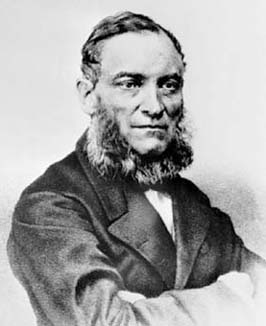


 تاريخ الرياضيات
تاريخ الرياضيات
 الرياضيات في الحضارات المختلفة
الرياضيات في الحضارات المختلفة 
 الرياضيات المتقطعة
الرياضيات المتقطعة
 الجبر
الجبر
 الهندسة
الهندسة 
 المعادلات التفاضلية و التكاملية
المعادلات التفاضلية و التكاملية 
 التحليل
التحليل
 علماء الرياضيات
علماء الرياضيات |
Read More
Date: 26-10-2016
Date: 5-11-2016
Date: 3-11-2016
|
Died: 12 December 1889 in St Petersburg, Russia

Viktor Yakovlevich Bunyakovskii's father, Yakov Vasilievich Bunyakovskii, was a colonel. Bunyakovskii was first educated at home and then went abroad, obtaining a doctorate from Paris in 1825 after working under Cauchy. Bunyakovskii submitted three doctoral theses in the spring of 1825. The first two were submitted together: Rotary motion in a resistant medium of a set of plates of constant thickness and defined contour around an axis inclined with respect to the horizon and Determination of the radius-vector in elliptical motion of planets. The third Heat propagation in solids was submitted later and accepted three weeks after the first two. More details of these works are given in [4], see also [5].
In 1826 Bunyakovskii left Paris and returned to St Petersburg. In this he played an important role in the development of mathematics in the Russian Empire for he brought back with him an expertise in applying Cauchy's theory of residues which were at that time unknown in the Russia Empire. See [5] for details. He also brought French probabilistic ideas which formed a basis for the development of probability in the Empire prior to the work of Chebyshev; details are given in [9].
Bunyakovskii studied and taught in St Petersburg for many years. He taught at a number of different institutions in St Petersburg, including the First Cadet Corps, the Communications Academy and later the Naval Academy. The courses he offered were on mathematics and mechanics. He was a professor at the University in St Petersburg from 1846 until 1880. His scientific research work, however, was not done at these institutions, but was carried out at the St Petersburg Academy of Sciences.
Two years after his return to St Petersburg from Paris, Bunyakovskii became an adjunct in mathematics at the Academy, then he was named an extraordinary academician in 1830 (here extraordinary means the same as in the German system, the equivalent of an associate professor in the present American system). Then in 1841 he was promoted to an ordinary academician at the Academy. In 1864 he became vice-president of the St Petersburg Academy of Sciences, a post which he held until his death.
Bunyakovskii published over 150 works on mathematics and mechanics. He is best known for his discovery of the Cauchy-Schwarz inequality, published in a monograph in 1859 on inequalities between integrals. This is twenty-five years before Schwarz's work. In the monograph Bunyakovskii gave some results on the functional form of the inequality. There are many reasons why certain theorems are not named after their discoverer but after a later rediscoverer. However, in the case of Bunyakovskii there seems no good reason at all why he should not have the credit for his discovery. One would have to note, however, that the terminology of mathematics is not universal and in some countries his theorem is correctly named, or named after Cauchy, Bunyakovskii and Schwarz. A history of the Cauchy-Bunyakovskii-Schwarz inequality is given in [8].
Bunyakovskii worked on number theory, geometry and applied mathematics. His work in number theory was important and he gave a new proof of Gauss's law of quadratic reciprocity. Dickson, in his book on the history of number theory, gives 40 references to papers of Bunyakovskii. In 1846 Bunyakovskii wrote a number theory work [1]:-
... in which he gave an original exposition of this science and its application to insurance and demography.
Bunyakovskii also worked on geometry. In 1853 he examined Euclid's fifth postulate, giving a critical account of previous attempts to prove it. He then attempted his own proof, unaware that Lobachevsky had invented non-euclidean geometry 25 years before and, although it was published, it had been rejected by Ostrogradski when it had been submitted for publication in the St Petersburg Academy of Sciences.
His work in applied mechanics and hydrostatistics are probably not his most important, but are still a good contribution to the subject. His 1846 book on probability Foundations of the mathematical theory of probability is usually recognised as providing the development of Russian probabilistic terminology. Bunyakovskii's book also attempts to make Laplace's Théorie analytique des probabilites (1812) more accessible.
Bunyakovskii is remembered in many ways other than for the formula which fails to bear his name. A medal and prize was instituted by the St Petersburg Academy of Sciences in 1875 for outstanding mathematical work. For example Voronoy is one of the recipients of the prize.
Books:
Articles:



|
|
|
|
كل ما تود معرفته عن أهم فيتامين لسلامة الدماغ والأعصاب
|
|
|
|
|
|
|
ماذا سيحصل للأرض إذا تغير شكل نواتها؟
|
|
|
|
|
|
|
جامعة الكفيل تناقش تحضيراتها لإطلاق مؤتمرها العلمي الدولي السادس
|
|
|